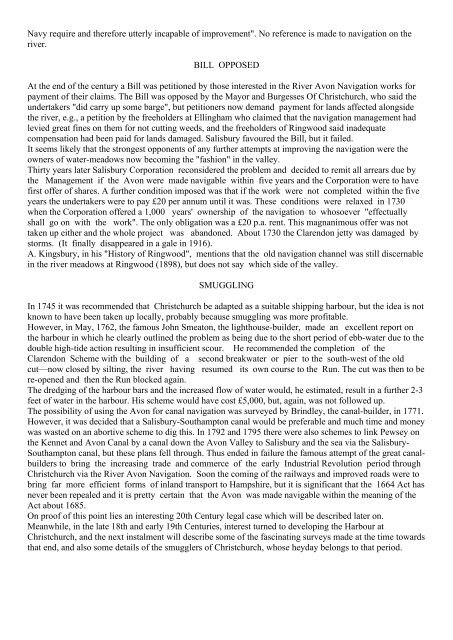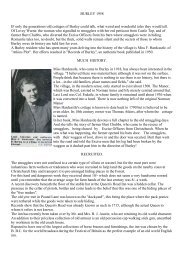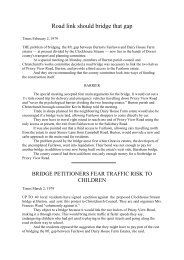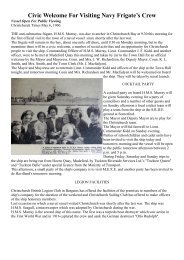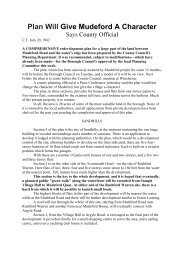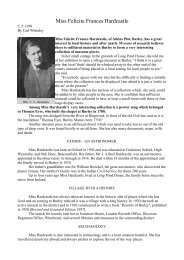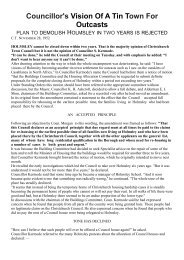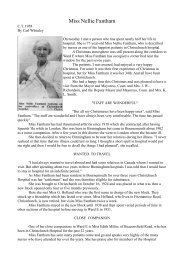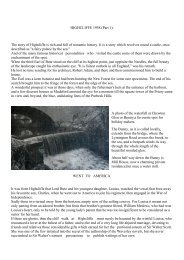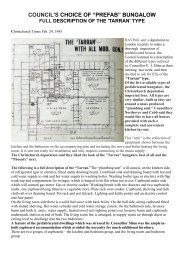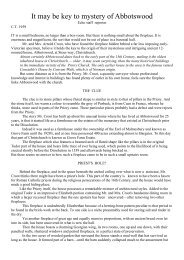Man and the Christchurch Avon 1963 - royhodges.co.uk
Man and the Christchurch Avon 1963 - royhodges.co.uk
Man and the Christchurch Avon 1963 - royhodges.co.uk
Create successful ePaper yourself
Turn your PDF publications into a flip-book with our unique Google optimized e-Paper software.
Navy require <strong>and</strong> <strong>the</strong>refore utterly incapable of improvement". No reference is made to navigation on <strong>the</strong><br />
river.<br />
BILL OPPOSED<br />
At <strong>the</strong> end of <strong>the</strong> century a Bill was petitioned by those interested in <strong>the</strong> River <strong>Avon</strong> Navigation works for<br />
payment of <strong>the</strong>ir claims. The Bill was opposed by <strong>the</strong> Mayor <strong>and</strong> Burgesses Of <strong>Christchurch</strong>, who said <strong>the</strong><br />
undertakers "did carry up some barge", but petitioners now dem<strong>and</strong> payment for l<strong>and</strong>s affected alongside<br />
<strong>the</strong> river, e.g., a petition by <strong>the</strong> freeholders at Ellingham who claimed that <strong>the</strong> navigation management had<br />
levied great fines on <strong>the</strong>m for not cutting weeds, <strong>and</strong> <strong>the</strong> freeholders of Ringwood said inadequate<br />
<strong>co</strong>mpensation had been paid for l<strong>and</strong>s damaged. Salisbury favoured <strong>the</strong> Bill, but it failed.<br />
It seems likely that <strong>the</strong> strongest opponents of any fur<strong>the</strong>r attempts at improving <strong>the</strong> navigation were <strong>the</strong><br />
owners of water-meadows now be<strong>co</strong>ming <strong>the</strong> "fashion" in <strong>the</strong> valley.<br />
Thirty years later Salisbury Corporation re<strong>co</strong>nsidered <strong>the</strong> problem <strong>and</strong> decided to remit all arrears due by<br />
<strong>the</strong> <strong>Man</strong>agement if <strong>the</strong> <strong>Avon</strong> were made navigable within five years <strong>and</strong> <strong>the</strong> Corporation were to have<br />
first offer of shares. A fur<strong>the</strong>r <strong>co</strong>ndition imposed was that if <strong>the</strong> work were not <strong>co</strong>mpleted within <strong>the</strong> five<br />
years <strong>the</strong> undertakers were to pay £20 per annum until it was. These <strong>co</strong>nditions were relaxed in 1730<br />
when <strong>the</strong> Corporation offered a 1,000 years' ownership of <strong>the</strong> navigation to whosoever "effectually<br />
shall go on with <strong>the</strong> work". The only obligation was a £20 p.a. rent. This magnanimous offer was not<br />
taken up ei<strong>the</strong>r <strong>and</strong> <strong>the</strong> whole project was ab<strong>and</strong>oned. About 1730 <strong>the</strong> Clarendon jetty was damaged by<br />
storms. (It finally disappeared in a gale in 1916).<br />
A. Kingsbury, in his "History of Ringwood", mentions that <strong>the</strong> old navigation channel was still discernable<br />
in <strong>the</strong> river meadows at Ringwood (1898), but does not say which side of <strong>the</strong> valley.<br />
SMUGGLING<br />
In 1745 it was re<strong>co</strong>mmended that <strong>Christchurch</strong> be adapted as a suitable shipping harbour, but <strong>the</strong> idea is not<br />
known to have been taken up locally, probably because smuggling was more profitable.<br />
However, in May, 1762, <strong>the</strong> famous John Smeaton, <strong>the</strong> lighthouse-builder, made an excellent report on<br />
<strong>the</strong> harbour in which he clearly outlined <strong>the</strong> problem as being due to <strong>the</strong> short period of ebb-water due to <strong>the</strong><br />
double high-tide action resulting in insufficient s<strong>co</strong>ur. He re<strong>co</strong>mmended <strong>the</strong> <strong>co</strong>mpletion of <strong>the</strong><br />
Clarendon Scheme with <strong>the</strong> building of a se<strong>co</strong>nd breakwater or pier to <strong>the</strong> south-west of <strong>the</strong> old<br />
cut—now closed by silting, <strong>the</strong> river having resumed its own <strong>co</strong>urse to <strong>the</strong> Run. The cut was <strong>the</strong>n to be<br />
re-opened <strong>and</strong> <strong>the</strong>n <strong>the</strong> Run blocked again.<br />
The dredging of <strong>the</strong> harbour bars <strong>and</strong> <strong>the</strong> increased flow of water would, he estimated, result in a fur<strong>the</strong>r 2-3<br />
feet of water in <strong>the</strong> harbour. His scheme would have <strong>co</strong>st £5,000, but, again, was not followed up.<br />
The possibility of using <strong>the</strong> <strong>Avon</strong> for canal navigation was surveyed by Brindley, <strong>the</strong> canal-builder, in 1771.<br />
However, it was decided that a Salisbury-Southampton canal would be preferable <strong>and</strong> much time <strong>and</strong> money<br />
was wasted on an abortive scheme to dig this. In 1792 <strong>and</strong> 1795 <strong>the</strong>re were also schemes to link Pewsey on<br />
<strong>the</strong> Kennet <strong>and</strong> <strong>Avon</strong> Canal by a canal down <strong>the</strong> <strong>Avon</strong> Valley to Salisbury <strong>and</strong> <strong>the</strong> sea via <strong>the</strong> Salisbury-<br />
Southampton canal, but <strong>the</strong>se plans fell through. Thus ended in failure <strong>the</strong> famous attempt of <strong>the</strong> great canalbuilders<br />
to bring <strong>the</strong> increasing trade <strong>and</strong> <strong>co</strong>mmerce of <strong>the</strong> early Industrial Revolution period through<br />
<strong>Christchurch</strong> via <strong>the</strong> River <strong>Avon</strong> Navigation. Soon <strong>the</strong> <strong>co</strong>ming of <strong>the</strong> railways <strong>and</strong> improved roads were to<br />
bring far more efficient forms of inl<strong>and</strong> transport to Hampshire, but it is significant that <strong>the</strong> 1664 Act has<br />
never been repealed <strong>and</strong> it is pretty certain that <strong>the</strong> <strong>Avon</strong> was made navigable within <strong>the</strong> meaning of <strong>the</strong><br />
Act about 1685.<br />
On proof of this point lies an interesting 20th Century legal case which will be described later on.<br />
Meanwhile, in <strong>the</strong> late 18th <strong>and</strong> early 19th Centuries, interest turned to developing <strong>the</strong> Harbour at<br />
<strong>Christchurch</strong>, <strong>and</strong> <strong>the</strong> next instalment will describe some of <strong>the</strong> fascinating surveys made at <strong>the</strong> time towards<br />
that end, <strong>and</strong> also some details of <strong>the</strong> smugglers of <strong>Christchurch</strong>, whose heyday belongs to that period.


